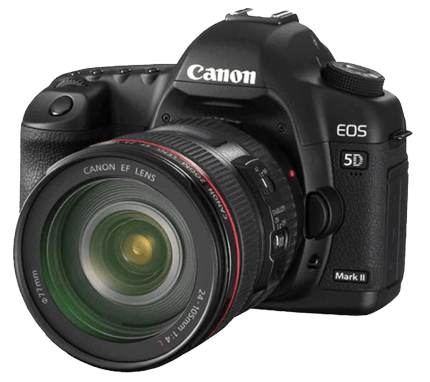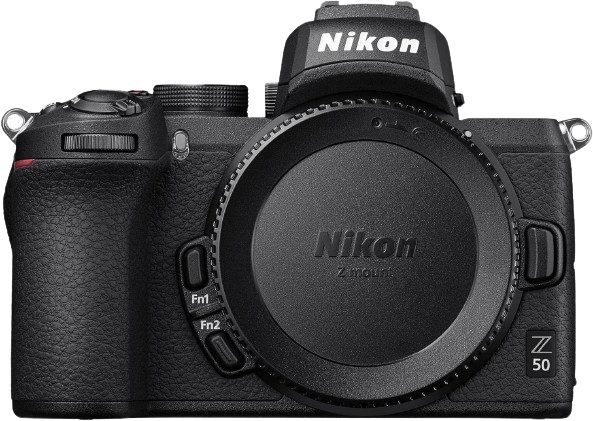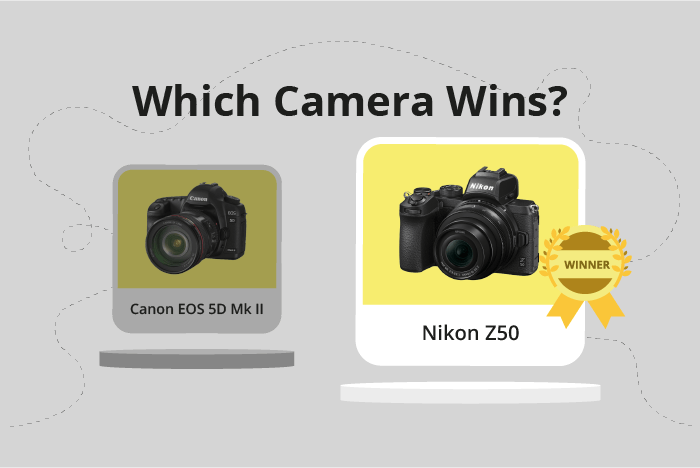Canon EOS 5D Mark II vs Nikon Z50 Comparison
Canon EOS 5D Mark II

Nikon Z50

The Nikon Z50 emerges as the winner with a score of 73/100, outshining Canon EOS 5D Mark II‘s score of 58/100. Both cameras share similarities, such as their launch prices, with the Nikon Z50 at $859 and the Canon EOS 5D Mark II at $2199. These cameras also have similar announcement dates, with the Nikon Z50 announced on 10/10/2019, and the Canon EOS 5D Mark II on 09/17/2008.
The Nikon Z50 is superior due to its lighter weight of 450g and smaller size of 127 x 94 x 60mm. Additionally, it is a mirrorless camera, which provides better image quality and performance. On the other hand, the Canon EOS 5D Mark II is a DSLR camera, weighing 850g and measuring 152 x 114 x 75mm. This camera has a lower score but still offers reliable performance and image quality.
Taking these factors into consideration, the Nikon Z50 is the better choice for photographers seeking a lightweight, mirrorless camera with superior performance. However, the Canon EOS 5D Mark II remains a reliable option for those who prefer DSLR cameras.
Canon EOS 5D Mark II vs Nikon Z50 Overview and Optics
The Nikon Z50 outperforms the Canon EOS 5D Mark II in optics, scoring 72/100 compared to the Canon’s 59/100. Both cameras share several specifications, such as having 21 megapixels, a CMOS sensor, and no image stabilization. However, the differences in other specifications contribute to the Nikon Z50’s superior performance.
The Nikon Z50 has a faster shooting speed of 11 frames per second, while the Canon EOS 5D Mark II lags behind with a shooting speed of 3.9 frames per second. This allows for capturing fast-moving subjects more efficiently. The Z50’s Expeed 6 processor also contributes to better image quality, whereas the 5D Mark II is equipped with an older Digic 4 processor.
Furthermore, the Nikon Z50 boasts a higher DXOMARK score of 97 for its sensor, compared to the Canon EOS 5D Mark II’s score of 79. This means the Z50 has better overall image quality, dynamic range, and low-light performance. The Z50 also uses the Nikon Z lens mount, which offers compatibility with a wide range of high-quality lenses.
On the other hand, the Canon EOS 5D Mark II features a full-frame sensor, while the Nikon Z50 has an APS-C sensor. This gives the 5D Mark II an advantage in terms of image quality and depth of field control. The Canon EF lens mount is also compatible with a vast selection of lenses, providing flexibility for various shooting situations.
Considering the optics, the Nikon Z50 is the better choice due to its faster shooting speed, superior processor, and higher DXOMARK score. However, the Canon EOS 5D Mark II may still appeal to photographers who prioritize full-frame sensor benefits and the extensive Canon EF lens lineup.
Canon EOS 5D Mark II vs Nikon Z50 Video Performance
The Nikon Z50 outperforms the Canon EOS 5D Mark II in video capabilities, boasting a video score of 91/100 compared to the Canon’s 43/100. Both cameras share some video features, such as recording in multiple formats and offering manual exposure control. However, the Nikon Z50 surpasses the Canon EOS 5D Mark II in several key aspects.
The Nikon Z50 offers superior video resolution, capturing 4K footage with dimensions of 3840 x 2160, while the Canon EOS 5D Mark II is limited to Full HD with dimensions of 1920 x 1080. This difference in resolution results in the Nikon Z50 producing significantly sharper and more detailed videos than the Canon EOS 5D Mark II.
Additionally, the Nikon Z50 provides a higher maximum video frame rate of 120fps, allowing for smoother footage and the ability to create slow-motion effects. In contrast, the Canon EOS 5D Mark II can only achieve a maximum frame rate of 30fps. Furthermore, the Nikon Z50 comes with built-in time-lapse functionality, a feature that the Canon EOS 5D Mark II lacks.
The Canon EOS 5D Mark II does not have any distinct advantages over the Nikon Z50 in terms of video capabilities. Its lower video score reflects its limitations in resolution, frame rate, and additional features.
Given the substantial difference in video scores, the Nikon Z50 is the clear winner when comparing video capabilities. Its 4K resolution, higher frame rate, and built-in time-lapse functionality make it a superior choice for videographers and content creators seeking a camera with robust video features.
Canon EOS 5D Mark II vs Nikon Z50 Features and Benefits
The Nikon Z50 takes the lead in features, scoring 86 points compared to the Canon EOS 5D Mark II’s 54 points. Both cameras share some common specifications, such as a 3-inch screen size, no GPS, and WIFI connectivity. However, the differences in their features become apparent when delving deeper into their specifications.
The Nikon Z50 outperforms the Canon EOS 5D Mark II in several aspects. The Z50 has a larger 3.2-inch screen with a higher resolution of 1,040,000 dots, compared to the 5D Mark II’s 920,000 dots. The Z50 also boasts a touchscreen, making it more user-friendly and intuitive to navigate. Additionally, the Z50 has a flip screen, providing more flexibility when composing shots at different angles. The presence of Bluetooth connectivity in the Z50 allows for seamless transferring of images and remote camera control.
On the other hand, the Canon EOS 5D Mark II does not have any significant advantages over the Nikon Z50 in terms of features. It lacks a touchscreen, flip screen, and Bluetooth connectivity, which puts it at a disadvantage compared to the Z50.
Based on the comparison of features, the Nikon Z50 emerges as the superior camera. Its higher-resolution screen, touchscreen capabilities, flip screen, and Bluetooth connectivity make it more versatile and user-friendly. The Canon EOS 5D Mark II falls short in these aspects, making it a less attractive option for photographers seeking a camera with advanced features. Therefore, the Nikon Z50 is the clear winner in this comparison, offering a more comprehensive set of features for photographers to utilize and enjoy.
Canon EOS 5D Mark II vs Nikon Z50 Storage and Battery
The Canon EOS 5D Mark II outperforms the Nikon Z50 in storage and battery with a score of 71 out of 100, compared to the Nikon Z50’s score of 35. Both cameras share similarities in memory card compatibility, with the Canon accepting Compact Flash (Type I or II), UDMA, and Microdrive cards, while the Nikon uses SD, SDHC, and SDXC (UHS-I compatible) cards.
The Canon EOS 5D Mark II excels with two memory card slots and a long-lasting battery life of 850 shots, powered by an LP-E6 battery. In contrast, the Nikon Z50 has only one memory card slot and a shorter battery life of 320 shots, using an EN-EL25 battery.
However, the Nikon Z50 offers USB charging, a feature absent in the Canon EOS 5D Mark II. This convenience can be valuable for users who need to recharge their camera on the go.
Considering storage and battery performance, the Canon EOS 5D Mark II proves superior with its dual memory card slots and extended battery life. The Nikon Z50, while having a lower score, still provides the advantage of USB charging, catering to users who prioritize charging flexibility.
Canon EOS 5D Mark II vs Nikon Z50 – Our Verdict
Are you still undecided about which camera is right for you? Have a look at these popular comparisons that feature the Canon EOS 5D Mark II or the Nikon Z50:

